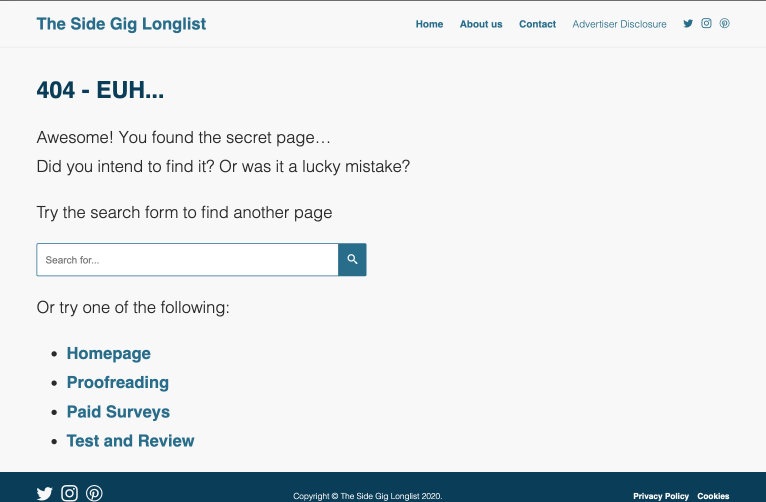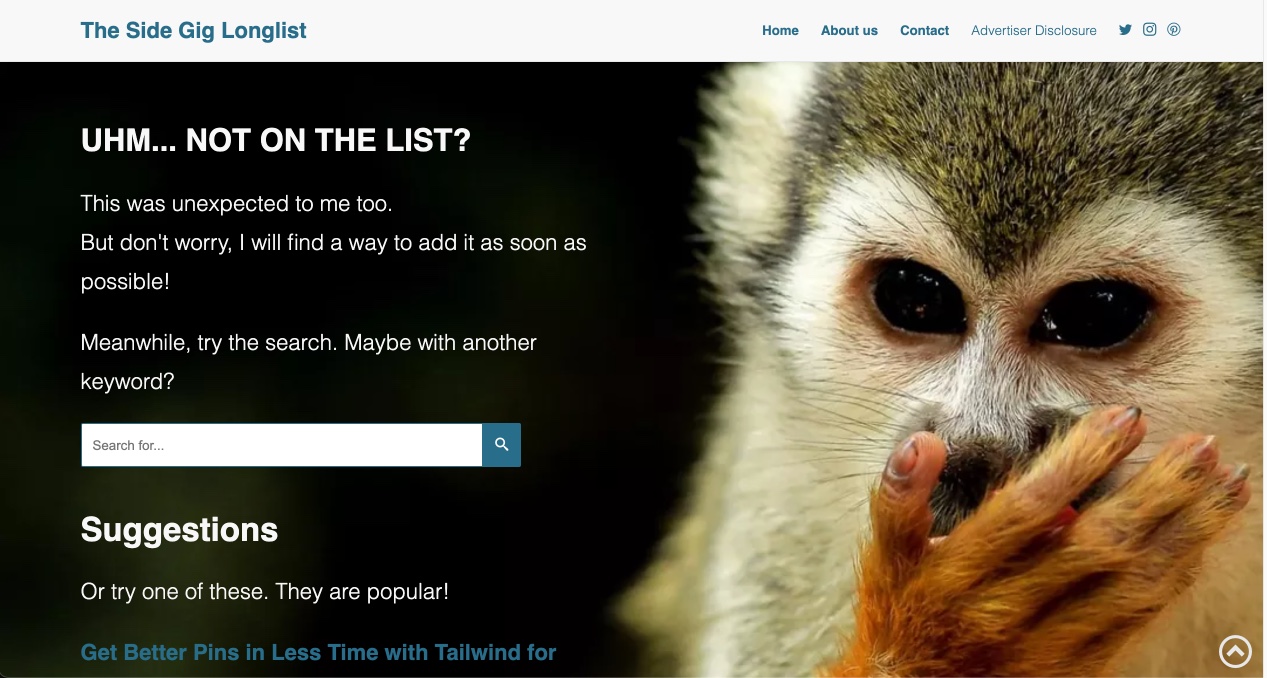Fix-It Friday – Get more out of a 404
This means that if you click on that link and purchase an item I will get a commission, at no extra cost to you!
The idea of this hopefully useful post is that I would like to explore and share with you how to get more out of a 404, or page not found, error.
Like a lot of bloggers, I am using WordPress as my CMS, but I expect that this information will also be useful if you use other platforms. Although the title does say ‘FixIt’, the way I handle 404 errors on my website works well. The whole idea is to find out if I can add value to both visitors and possibly get more engagement by optimizing the current solution.
Don’t worry that it might get technical. I am used to explaining technical concepts to non-tech people around me.
Fix-It Friday
When I started The Side Gig Longlist, my main purpose was to explore what it takes to become a blogger.
Technically speaking, I am blogging already.
However, I want to up my level and really find out what it takes to write great content.
Finding an audience (traffic), and keeping them engaged, is still an unknown art to me.
I believe that it takes great skills to keep the right balance in providing valuable content and actually market it.
Inner Nerd vs Inner Writer
There is a lot to learn there for me. And although I am skilled and comfortable with tech, being a developer and a bit of a nerd, there is also a lot to learn there.
The problem is that I need to find a balance in writing content and ‘playing’ around in the code. The latter is very tempting, but the first is where I want to acquire more skills and experience.
To keep my ‘inner nerd’ happy, I decided that Friday is the day that I can give in to the tech craving.
I did notice a shift in the balance though. My ‘inner writer’ seems to wake up and demands attention.
To keep both happy, I decided to try out a series of posts, explaining how and why I do some technical improvements, bug fixes, maintenance, etcetera.
Let’s find out if this works.
Side note: I have learned already that it takes a lot of time to prepare a post before publishing it, so no guarantees that this post is published on Friday, but I will try!
Saturdays edit: I didn’t make the deadline.
404 – Not Found
When someone tries to visit your website and enters an address (URL) that does not exist, the server where your website is hosted will reply with a 404 error, basically telling your browser that it could not find what you requested.
Not an Error
Actually, calling it an error is incorrect, as this is how HTTP, the protocol for webpages, is designed. Try to see it as a language, where your computer (the client) talks to another computer (the server). ‘404’ is the word for ‘not found’ in this language.
Other ‘words’ are 200 (OK) or 301 (Moved Permanently). If you would like to find out more, then this Wiki will be a good starting point: List_of_HTTP_status_codes
When Does This Happen and Why Should You Care
There are a lot of reasons why this happens, and they all are important to you as a blogger. Let’s go through the most common reasons 404’s occur.
Typso (Phun Intended)
Typos are easily made. In fact, the typo in this title is legit. As Grammarly wanted to correct the typo in this title, I decided to keep it for fun.
The URL your (potential) visitors enter in the browser needs to match exactly to how it is known on your webserver.
Sometimes it is very understandable that users typed the wrong URL as some servers are case-sensitive. These servers don’t see www.youfoundmyblog.com as the same as www.YouFoundMyBlog.com and will present the visitor with a 404.
Typos may also occur in backlinks to your page, leaving visitors puzzled as they expected an awesome post, following that link from another page they visited. They will probably think that you have a problem with your website…
Content Not Found (For Real)
Another reason why someone gets a 404 answer is when there is actually no content at the given URL.
The reasons for this are also diverse, but try to think of (back)links to deleted or renamed posts. Or maybe you forgot to publish and the post is still in your drafts. These links are called dead or broken.
It is a good practice to check your website for broken links frequently.

A lot of 404’s are also caused by bots or hackers trying to find potential weaknesses of your website by scanning for known files to exploit.
And bots (like the ones that search engines use) may be looking for resources that help them index your website.
Why Should You Care
If you manage to get information on all these requests that return a 404 it will give you an incredible amount of information!
You can take this information to redirect the visitor to the right page, thereby converting a disappointed visitor into a happy one (and maybe even a lead).
I will cover redirection later in this post.
It also gives you information on what it is that visitors, both humans, and bots, were looking for. This may give you input to tighten the security of your website, improve your SEO strategy, or even write a nice post.
Google Does not Like 404’s (But Not As You Thought)
There are a lot of articles on the web about this topic. As Google keeps its algorithms secret, most of these articles are opinions. The following is my opinion.
404’s are a natural part of the web and Google recognizes that. If a link to your page results in a 404, it does not impact your ranking.
Just think of what your competitors could do with that if it would…
However. If you link to a page on another website, and that link returns a 404, then that might negatively affect your ranking. Make sure you are not creating 404 by checking your outgoing URL regularly.
This is a nice topic, but for another time, as I’m focusing on the 404 on our own website in this post.
That being said: Handling a 404 in a proper way may contribute in a positive manner to your ranking.
Fewer visitors will leave your site immediately (bounce), and they may even engage with content they were not looking for, navigating through your pages.
Create a 404 Page
If you do not handle 404, by leading your visitors to a 404 page, then this is what your visitor sees:

Not very engaging content isn’t it? You can’t blame a visitor for leaving (and maybe never come back).
So the first thing you should do is create a more appealing page and lead all 404 traffic to it.
Don’t redirect to an existing page that probably has nothing to do with what your user is looking for. Some sites redirect to the homepage, which is a bad idea.
Make sure to communicate to them that ‘you’ can’t find what they are looking for and try to help them in taking the next step, preferably on your website.
Content Management Systems to the Rescue
Most Content Management Systems, like WordPress, will help you implement this best practice by default. There probably is a solution present already.
I have adapted the 404 of The Side Gig Longlist, trying to make a little joke, hoping to create a smile.
By presenting a search option and some links I hope that visitors start exploring.

I am not completely satisfied with it, but for now, it works. In fact, I started this article because I wanted to find out what I can do to make it more appealing to my visitors and possibly converting to leads.
Instead, I am still writing this post (don’t worry, I will come to it later on, but I’m not sure if I can complete all of this today…)
How to Set or Customize Your 404
It all depends on your CMS.
For WordPress, most themes have a 404 Template. You should be able to find it under ‘Appearance > Customize’.
I made mine from scratch and had to add my own 404 template page.
This does take a bit of HTML and PHP knowledge, but it’s not rocket science.
To do this, I didn’t even use special tools for it as Hostinger, my hosting provider, allows me to edit files directly on the server.
Always make sure that you make backups if you do this!
If you use WordPress and would like to get your fingers in the code, then this article might help: 404-pages
Finding and Redirecting 404’s
There are several plugins available that will give you information about all 404 requests. I am using the (free) Redirection plugin and I am very happy with it so far.
Some security plugins will also give you information on catcher 404 (for instance the All In One WordPress Security and Firewall plugin)
As the first plugin will let you redirect 404 traffic and the latter gives you more information and security-related options, it might be a good idea to use both.
Finding 404’s
The Redirection plugin has a 404 tab.
When you open it, you will get an overview of all 404’s registered:

It will provide you with information about the URL, the time it was registered, and the user agent of the browser your visitor was using.
The User-Agent Information will come in handy if you need to determine if your visitor, for instance, was human or a bot.
More information about User Agents can be found here: User_agent.
We saw that there was a request to ‘ /cnava’ in my logs.
If I try this link then I am presented with a 404 page.
When I open an inspector (for instance in Chrome) then you can see in the ‘Network’ tab that a 404 was registered:

Create a Redirect
When you create a redirect you are basically telling the server that you want page A to be served if B was requested.
You can also create a redirect from here. Hover the link and chose ‘Add Redirect’
The Redirection plugin presents me with a form like this:

I entered ‘/canva’ as the Target URL This is a relative URL. The full URL would be ‘https://thesidegiglonglist/canva’.
As I redirect to the page that I think this link was intended to find, I gave it a code: ‘301 – Moved Permanently’. Remember the part where I spoke about the HTTP Protocol. 301 is the code to tell that this page is the definitive page.
Now, when I click the same ‘/cnava’ link, I am redirected to the page that was intended. You can also see it in the Network tab of the Inspector tool:

Back to the 404
Right… 2000 words later and I still haven’t optimized my 404 landing page, but I really hope that all this information is useful to you.
Let’s get back to what I want to accomplish:
- ‘flip’ the mindset that visitors may get into because this is not what they were expecting into a positive/engaging one
- the 404 should have more value/be useful to the visitor that landed here
- maybe even generate some sales opportunities
Create a smile
It is hard to be disappointed and smile at the same time. Let’s try to create a smile, so my visitors get into a more positive vibe.
To do this, I added a picture of a cute monkey with a surprised expression on its face.
Combined with a light and slightly amusing text that fits better to the whole ‘list’ concept, I believe that the first impression of it will make it hard not to smile.
Add Value
The way I see it, I can add value to this page by either helping the visitor find what he or she was looking for or to offer help in finding something else that might be related.
I didn’t manage to find a suitable ‘Did you mean…’ piece of code (or plugin), so presenting help to search my blog is the least I can do.
By offering a top 5 of what is popular and a link to my special offers page I am taking a lucky shot, but on the other hand, it might be useful to my guest.
Wrapping it Up
If I still haven’t managed to please my visitor then it is time to wrap things up.
By emphasizing that I actively review all 404’s and will do my best to add topics to my blog based on this (which I do) I hope that they will return later on and check again.
I also want to make sure that I have done everything I could do to help, so as a final attempt I offer them to contact me.
What does it Look Like Now?
The best way to view it is to take a look at it of course, but for the sake of this post I will add a screenshot here:

Personally, I am very content with how it looks.
Of course, it will take some time to find out if works out the way I expect it to do.
Conclusion
By now I hope that you have learned a little more about the value of these 404’s.
You will get a lot of information from it if you review the 404’s on your website frequently.
It will help to find issues fast and it might even bring your attention to find out what your visitors are looking for.
The 404 page is also a great place to provide service to your visitors and show them that you care.
What do you think? Have I missed something or do you have some great tips concerning this topic?
Leave a comment and share it with us!
What’s Next
Well, if you liked this post, then I would really appreciate it if you shared it on your social media.
Thank you for visiting! You are awesome!



Leave a Reply